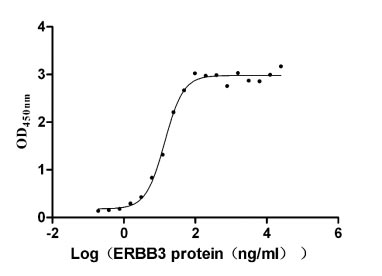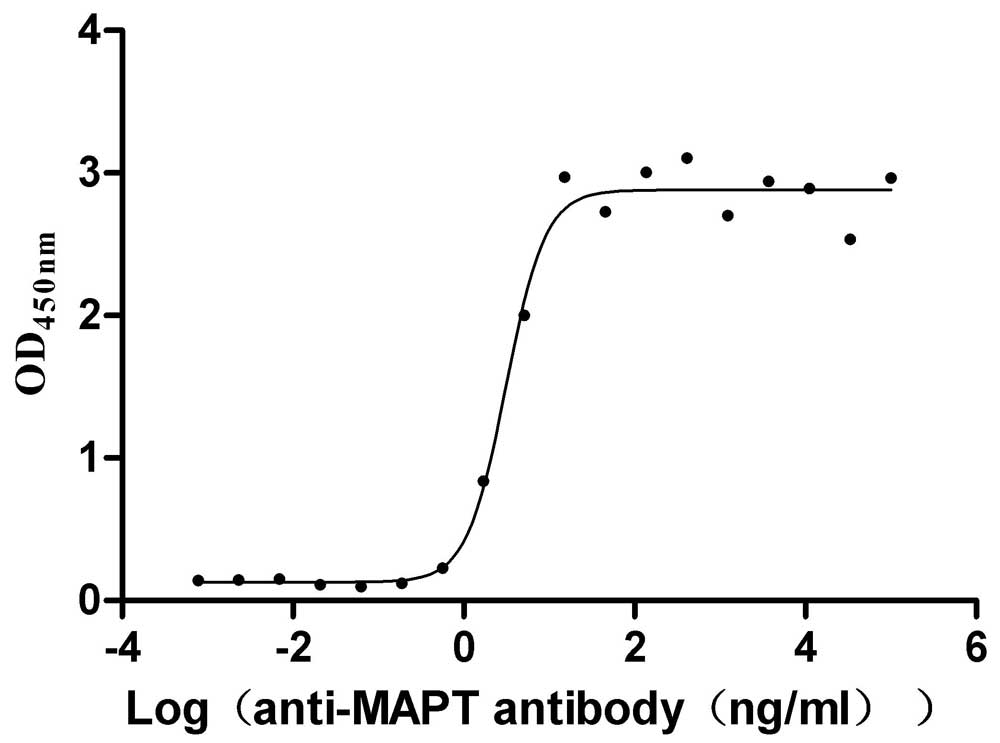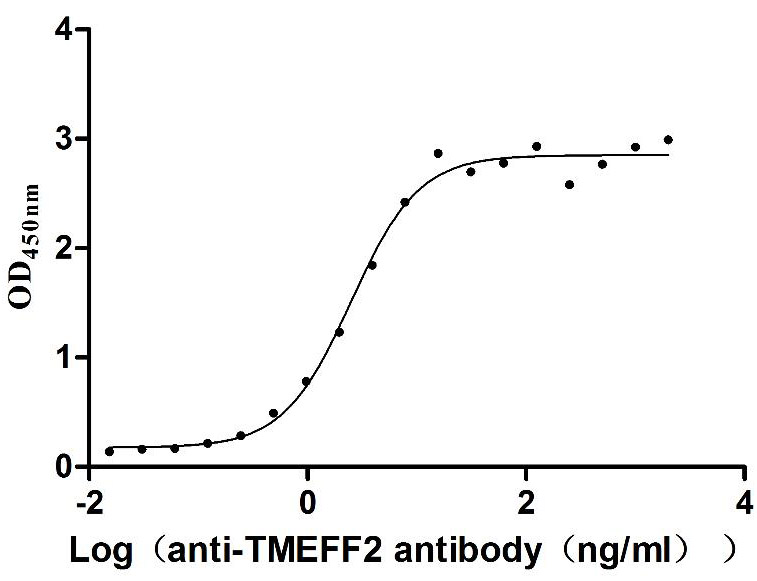Recombinant Rat Carcinoembryonic antigen-related cell adhesion molecule 1 (Ceacam1)
-
货号:CSB-CF005157RA
-
规格:
-
来源:in vitro E.coli expression system
-
其他:
产品详情
-
基因名:
-
Uniprot No.:
-
别名:Ceacam1; Carcinoembryonic antigen-related cell adhesion molecule 1; ATP-dependent taurocolate-carrier protein; Cell-CAM 105; C-CAM 105; GP110; pp120; CD antigen CD66a
-
种属:Rattus norvegicus (Rat)
-
蛋白长度:Full Length of Mature Protein
-
表达区域:35-519
-
氨基酸序列QVTVDAVPPNVVEESSVLLLTHNLPQEFQVFYWYKVTTTGLNSEIARYIRSSNTSQTEPAYSGRVTIYSNGSLFFQNVNKTDEGPYTLSVIDKQFNPIQTSVQFRVYPALQKPNVTGNNSNPMEGEPFVSLMCEPYTNNTSYLWSRNGESLSEGDRVTFSEGNRTLTLLNVRRTDKGYYECEARNPATFNRSDPFNLDVIYGPDAPVISPPDIYLHQGSNLNLSCHADSNPPAQYFWLINEKLQTSSQELFISNITTNNSGTYACFVNNTVTGLSRTTVKNITVFEPVTQPSIQITNTTVKELGSVTLTCFSKDTGVSVRWLFNSQSLQLTDRMTLSQDNSTLRIDPIKREDAGDYQCEISNPVSFRISHPIKLDVIPDPTQGNSGLSEGAIAGIVIGSVAGVALIAALAYFLYSRKTGGGSDHRDLTEHKPSTSSHNLGPSDDSPNKVDDVSYSVLNFNAQQSKRPTSASSSPTETVYSVVKKK
Note: The complete sequence including tag sequence, target protein sequence and linker sequence could be provided upon request. -
蛋白标签:N-terminal 10xHis-tagged
-
产品提供形式:Liquid or Lyophilized powder
Note: We will preferentially ship the format that we have in stock, however, if you have any special requirement for the format, please remark your requirement when placing the order, we will prepare according to your demand. -
缓冲液:Lyophilized from Tris/PBS-based buffer, 6% Trehalose, pH 8.0
-
储存条件:Store at -20°C/-80°C upon receipt, aliquoting is necessary for mutiple use. Avoid repeated freeze-thaw cycles.
-
保质期:The shelf life is related to many factors, storage state, buffer ingredients, storage temperature and the stability of the protein itself.
Generally, the shelf life of liquid form is 6 months at -20°C/-80°C. The shelf life of lyophilized form is 12 months at -20°C/-80°C. -
货期:Basically, we can dispatch the products out in 1-3 working days after receiving your orders. Delivery time may differ from different purchasing way or location, please kindly consult your local distributors for specific delivery time.Note: All of our proteins are default shipped with normal blue ice packs, if you request to ship with dry ice, please communicate with us in advance and extra fees will be charged.
-
注意事项:Repeated freezing and thawing is not recommended. Store working aliquots at 4°C for up to one week.
-
Datasheet & COA:Please contact us to get it.
相关产品
靶点详情
-
功能:Cell adhesion protein that mediates homophilic cell adhesion in a calcium-independent manner. Plays a role as coinhibitory receptor in immune response, insulin action and functions also as an activator during angiogenesis. Its coinhibitory receptor function is phosphorylation- and PTPN6 -dependent, which in turn, suppress signal transduction of associated receptors by dephosphorylation of their downstream effectors. Plays a role in immune response, of T-cells, natural killer (NK) and neutrophils. Upon TCR/CD3 complex stimulation, inhibits TCR-mediated cytotoxicity by blocking granule exocytosis by mediating homophilic binding to adjacent cells, allowing interaction with and phosphorylation by LCK and interaction with the TCR/CD3 complex which recruits PTPN6 resulting in dephosphorylation of CD247 and ZAP70. Also inhibits T-cell proliferation and cytokine production through inhibition of JNK cascade and plays a crucial role in regulating autoimmunity and anti-tumor immunity by inhibiting T-cell through its interaction with HAVCR2. Upon natural killer (NK) cells activation, inhibit KLRK1-mediated cytolysis of CEACAM1-bearing tumor cells by trans-homophilic interactions with CEACAM1 on the target cell and lead to cis-interaction between CEACAM1 and KLRK1, allowing PTPN6 recruitment and then VAV1 dephosphorylation. Upon neutrophils activation negatively regulates IL1B production by recruiting PTPN6 to a SYK-TLR4-CEACAM1 complex, that dephosphorylates SYK, reducing the production of reactive oxygen species (ROS) and lysosome disruption, which in turn, reduces the activity of the inflammasome. Downregulates neutrophil production by acting as a coinhibitory receptor for CSF3R by downregulating the CSF3R-STAT3 pathway through recruitment of PTPN6 that dephosphorylates CSF3R. Also regulates insulin action by promoting INS clearance and regulating lipogenesis in liver through regulating insulin signaling. Upon INS stimulation, undergoes phosphorylation by INSR leading to INS clearance by increasing receptor-mediated insulin endocytosis. This inernalization promotes interaction with FASN leading to receptor-mediated insulin degradation and to reduction of FASN activity leading to negative regulation of fatty acid synthesis. INSR-mediated phosphorylation also provokes a down-regulation of cell proliferation through SHC1 interaction resulting in decrease coupling of SHC1 to the MAPK3/ERK1-MAPK1/ERK2 and phosphatidylinositol 3-kinase pathways. Functions as activator in angiogenesis by promoting blood vessel remodeling through endothelial cell differentiation and migration and in arteriogenesis by increasing the number of collateral arteries and collateral vessel calibers after ischemia. Also regulates vascular permeability through the VEGFR2 signaling pathway resulting in control of nitric oxide production. Downregulates cell growth in response to EGF through its interaction with SHC1 that mediates interaction with EGFR resulting in decrease coupling of SHC1 to the MAPK3/ERK1-MAPK1/ERK2 pathway. Negatively regulates platelet aggregation by decreasing platelet adhesion on type I collagen through the GPVI-FcRgamma complex. Inhibits cell migration and cell scattering through interaction with FLNA; interfers with the interaction of FLNA with RALA. Mediates bile acid transport activity in a phosphorylation dependent manner. Negatively regulates osteoclastogenesis.; Cell adhesion proteins that mediates homophilic cell adhesion in a calcium-independent manner. Promotes populations of T-cells regulating IgA production and secretion associated with control of the commensal microbiota and resistance to enteropathogens.
-
基因功能参考文献:
- CEACAM8 interacts with CEACAM1 inhibiting TLR2-triggered immune responses PMID: 24743304
- the transmembrane domain is an important determinant of CEACAM1-4S functionality PMID: 22235309
- ovariectomy decreases the mineralization process and the osteocalcin expression during the chronology of the alveolar healing process that is not totally recovered with estrogen replacement or raloxifene treatment. PMID: 20036346
- Two novel splice variants, designated CEACAM1-4C1 and CEACAM1-4C2, lacking the transmembrane region, were identified in this study. PMID: 11922629
- Both long and short cytoplasmic domain isoforms of Ceacam1 are expressed in rat neutrophils, B cells, and T-cells. PMID: 11994468
- the transmembrane domain of CEACAM1 is responsible for the Cdc42-induced targeting at cell-cell contacts PMID: 14517298
- the N-domain of CEACAM1 shows evidence of recombination PMID: 15184366
- CEACAM1 influences the resolution of inflammation by prolonging the survival of rat granulocytes. PMID: 15909305
- CEACAM1 mediates contact inhibition of proliferation in cells that are constantly exposed to growth factors, but co-activates growth-factor-induced proliferation in cells that have been starved for growth factors. PMID: 15950623
- PDIP38 can shuttle between the cytoplasmic and the nuclear compartments and that its subcellular localization is regulated by CEACAM1 PMID: 17623671
- CEACAM1 is a direct target of SOX9 in the colon epithelium PMID: 18794798
- A mechanism involving adhesion-influenced dynamic changes of CEACAM1 microcluster organization exists in epithelial cells. PMID: 19948502
- Transmembrane signaling by CEACAM1 operates by alteration of the monomer/dimer equilibrium, which leads to changes in the SHP-2 phosphatase/c-Src kinase-binding ratio. PMID: 19948503
显示更多
收起更多
-
亚细胞定位:[Isoform 1]: Cell membrane; Single-pass type I membrane protein. Lateral cell membrane. Apical cell membrane. Basal cell membrane. Cell junction. Cell junction, adherens junction.; [Isoform 2]: Cell membrane; Single-pass type I membrane protein. Lateral cell membrane. Apical cell membrane. Basal cell membrane. Cell junction. Cell junction, adherens junction. Cytoplasmic vesicle, secretory vesicle.; Cell projection, microvillus membrane; Single-pass type I membrane protein. Apical cell membrane; Single-pass type I membrane protein.
-
蛋白家族:Immunoglobulin superfamily, CEA family
-
组织特异性:Expressed in epithelia, vessel endothelia, leukocytes and platelets. Isoform 1 and isoform 2 are highly expressed in liver and intestine, moderately in lung, and weakly in muscle, kidney, and spleen. Expressed in granulocytes, lymphocytes, granulocytes, B
-
数据库链接:
KEGG: rno:81613
STRING: 10116.ENSRNOP00000046654
UniGene: Rn.91235
Most popular with customers
-
Recombinant Human Glypican-3 (GPC3) (G537R), partial (Active)
Express system: Mammalian cell
Species: Homo sapiens (Human)
-
Recombinant Human Receptor tyrosine-protein kinase erbB-3 (ERBB3), partial (Active)
Express system: Mammalian cell
Species: Homo sapiens (Human)
-
Recombinant Human Nectin-4 (NECTIN4), partial (Active)
Express system: Mammalian cell
Species: Homo sapiens (Human)
-
Recombinant Macaca mulatta Microtubule-associated protein tau (MAPT) (Active)
Express system: Mammalian cell
Species: Macaca mulatta (Rhesus macaque)
-
Recombinant Human Claudin-6 (CLDN6)-VLPs (Active)
Express system: Mammalian cell
Species: Homo sapiens (Human)
-
Recombinant Human Claudin-6 (CLDN6)-VLPs, Fluorescent (Active)
Express system: Mammalian cell
Species: Homo sapiens (Human)
-
Recombinant Human Tomoregulin-2 (TMEFF2), partial (Active)
Express system: Mammalian cell
Species: Homo sapiens (Human)
-
Recombinant Human C-type lectin domain family 4 member C (CLEC4C), partial (Active)
Express system: Mammalian cell
Species: Homo sapiens (Human)


-AC1.jpg)



-AC1.jpg)
f4-AC1.jpg)












